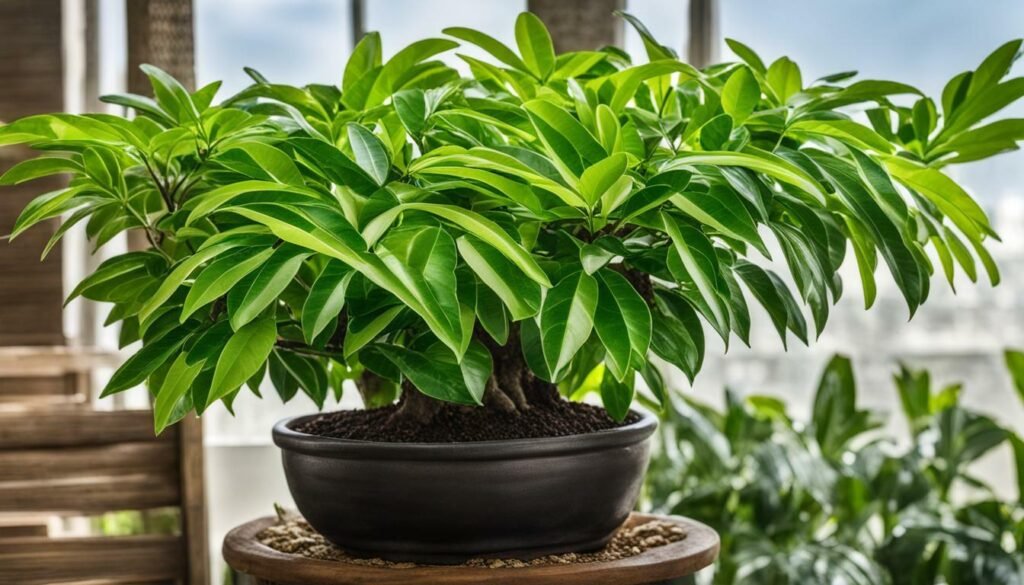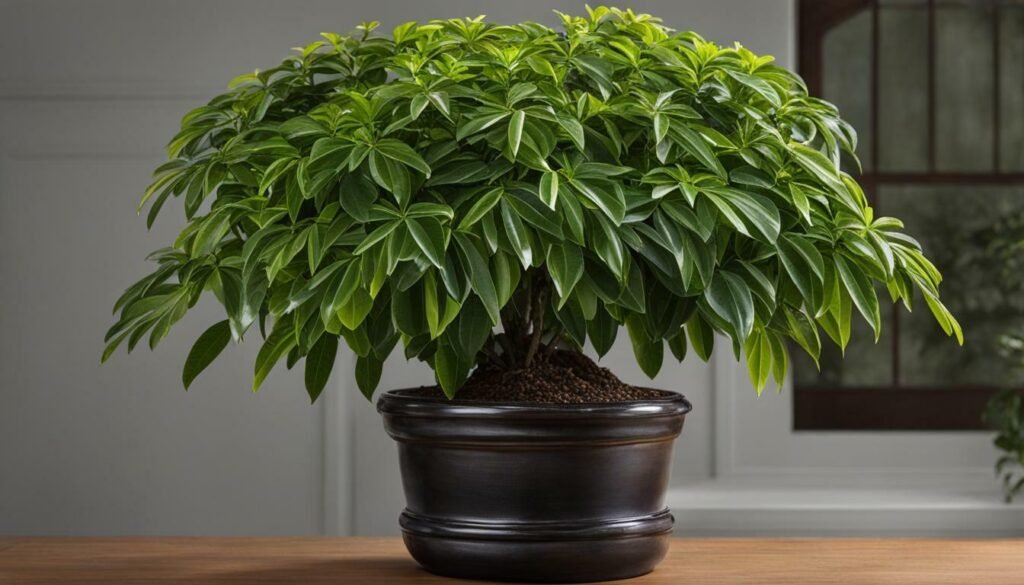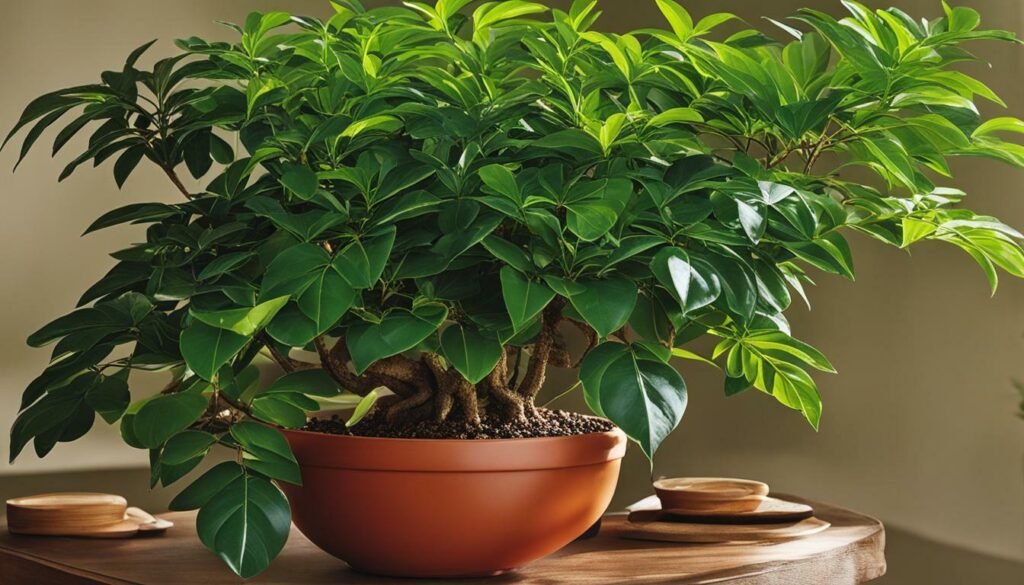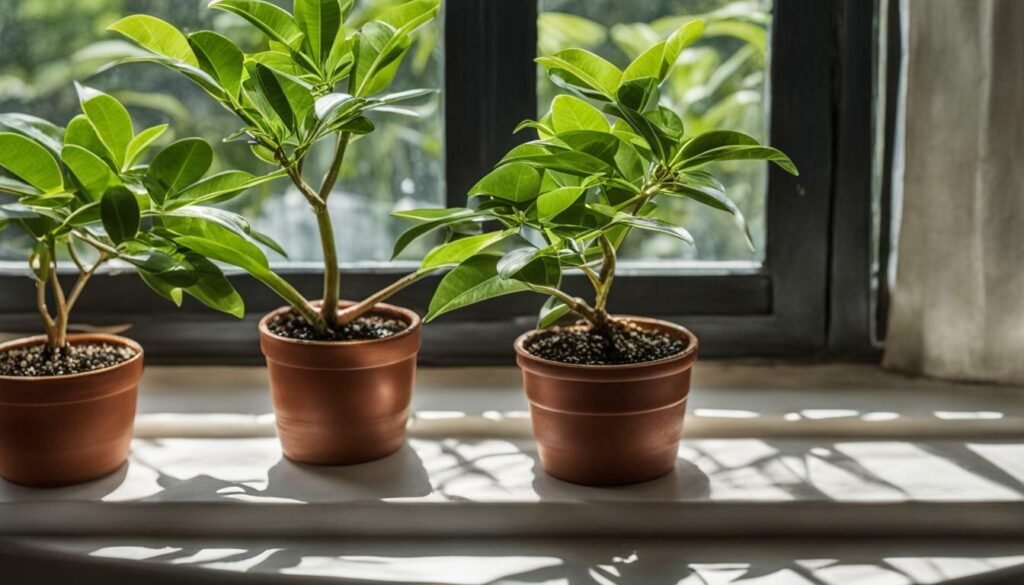Dwarf ‘Schefflera’ is a popular indoor plant known for its small size, glossy leaves, and air purifying qualities. This evergreen tropical plant requires proper care and maintenance to thrive in your home. In this comprehensive guide, I will provide you with all the information you need to keep your Dwarf Schefflera healthy and vibrant.
Table of Contents
ToggleKey Takeaways:
- Dwarf Schefflera is an indoor plant with small size and glossy leaves.
- It has air purifying qualities, making it a great addition to any home.
- Proper lighting, watering, and pruning are essential for its care.
- It thrives in average household temperatures and higher humidity levels.
- Fertilize once a month and propagate through cuttings if desired.
What is Dwarf Schefflera?
Dwarf Schefflera, also known as Dwarf Umbrella Tree or Hawaiian Umbrella Tree, is an indoor plant that retains its green foliage all year round, making it an evergreen addition to any household. These plants are classified as indoor plants and are popular choices for houseplant enthusiasts due to their tropical origins and low maintenance nature.
The Dwarf Schefflera is a small-sized plant with glossy leaves that add a touch of elegance to any space. It thrives in filtered indirect light and requires at least four hours of light per day to stay healthy and vibrant. In terms of watering, it’s essential to water the plant when the soil is dry, ensuring that the water saturates the soil completely. The plant prefers loose, nutrient-rich potting soil that retains moisture but also allows for proper drainage.
Ideal temperature and humidity conditions are crucial for the well-being of Dwarf Schefflera. These plants thrive in average household temperatures ranging from 60-75°F and benefit from higher humidity levels. Their tropical nature makes them more tolerant of humidity than other indoor plants, so maintaining a humid environment can help them thrive.
Table: Lighting and Watering Requirements
| Lighting Requirements | Watering Requirements |
|---|---|
| Filtered indirect light | Water when the soil is dry |
| At least 4 hours of light per day | Ensure thorough saturation of soil |
| Avoid direct sunlight | Allow the soil to dry out between waterings |
Proper care and maintenance go beyond lighting and watering. Pruning and cleaning play a significant role in maintaining the health and appearance of Dwarf Schefflera. Regular pruning helps keep the plant in shape and stimulates fuller growth, while cleaning the leaves removes dust and promotes better photosynthesis. Additionally, rotating the plant ensures that all sides receive an equal amount of light, preventing lopsided growth.
Fertilizing and propagation are also important aspects of caring for Dwarf Schefflera. Fertilize the plant once a month with a diluted complete fertilizer during the growing season to provide the necessary nutrients for optimal growth. Propagation can be done through cuttings, offering an opportunity to grow new plants from existing ones. Repotting is recommended annually or when the plants outgrow their containers.
To prevent common problems and diseases, it’s essential to be aware of the potential risks. Dwarf Schefflera can be susceptible to pests such as spider mites and mealybugs, which can be eliminated with water and soap or insecticides if necessary. Overwatering can lead to root rot, the most common disease affecting Schefflera plants. Proper care, including correct watering practices and providing sufficient light, can prevent these issues from occurring.

Overall, Dwarf Schefflera is a low-maintenance indoor plant that adds beauty and greenery to any space. With the right care and attention, these plants can thrive and bring a tropical touch to your home or office environment. By following the proper care guidelines, including lighting, watering, pruning, and cleaning, you can ensure the longevity and health of Dwarf Schefflera, enjoying its lush foliage for years to come.
Caring for Dwarf Schefflera
Caring for Dwarf Schefflera is relatively easy due to its low maintenance needs, and it also serves as an effective air purifier with its glossy leaves and small size. These tropical plants require proper care and attention to thrive indoors. Here are some essential tips to ensure the health and longevity of your Dwarf Schefflera:
Lighting and Watering Requirements
Dwarf Schefflera prefers filtered indirect light, making it suitable for various indoor environments. Place the plant near a window with sheer curtains or in a well-lit room, ensuring it receives at least four hours of light per day. Avoid exposing it to direct sunlight, as it can scorch the leaves.
When it comes to watering, it is essential to strike a balance. Water the plant thoroughly when the top inch of soil is dry, allowing the water to saturate the soil completely. Overwatering can lead to root rot, while underwatering can cause the leaves to turn yellow and drop. Ensure the pot has proper drainage to prevent waterlogging.
Ideal Temperature and Humidity
Dwarf Schefflera thrives in average household temperatures ranging from 60-75°F (15-24°C). Avoid exposing the plant to extreme temperature fluctuations, such as cold drafts or hot air vents. Higher humidity levels are beneficial, as they mimic the plant’s tropical habitat. Consider using a humidifier or placing the pot on a tray filled with pebbles and water to increase humidity.
Pruning and Cleaning
Regular pruning helps maintain the shape and fullness of Dwarf Schefflera. Trim any leggy or overgrown branches to encourage new growth. Additionally, cleaning the leaves periodically with a damp cloth or gentle spray of water removes dust and keeps the plant healthy. Remember to rotate the plant occasionally to ensure uniform growth.
Fertilizing and Propagation
Fertilize Dwarf Schefflera once a month during the growing season using a diluted complete fertilizer. This provides the necessary nutrients for healthy growth. Propagation can be done through stem cuttings, which should be rooted in moist soil or water. Repotting is recommended annually or when the plant outgrows its current container.

By following these care guidelines, you can enjoy the beauty and benefits of Dwarf Schefflera. With its low maintenance nature, air-purifying properties, small size, and glossy leaves, it is an excellent choice for indoor plant enthusiasts.
| Key Care Tips for Dwarf Schefflera | |
|---|---|
| Lighting | Filtered indirect light, avoid direct sunlight |
| Watering | Thoroughly water when the top inch of soil is dry, ensure proper drainage |
| Temperature | Average household temperatures of 60-75°F (15-24°C) |
| Humidity | Higher humidity levels, consider using a humidifier or tray with water and pebbles |
| Pruning | Regularly trim leggy or overgrown branches to maintain shape |
| Cleaning | Periodically clean leaves with a damp cloth or gentle spray of water |
| Fertilizing | Fertilize once a month with a diluted complete fertilizer during the growing season |
| Propagation | Propagate through stem cuttings rooted in moist soil or water |
| Repotting | Recommended annually or when the plant outgrows its container |
Lighting and Watering Requirements
Providing Dwarf Schefflera with filtered indirect light and watering it when the soil is dry is essential for its overall health and well-being. These plants thrive in bright but indirect light, which helps prevent leggy growth and keeps the foliage vibrant. Placing them near a north or east-facing window is ideal, as they can benefit from the soft, diffused light.
When it comes to watering, it’s important to maintain a careful balance. Overwatering can lead to root rot and other complications, while underwatering can cause the leaves to yellow and the plant to decline. The key is to let the top inch of soil dry out before watering. This ensures that the roots have access to the moisture they need without sitting in soggy soil.
As for drainage, using a well-draining potting mix is crucial. This allows excess water to flow out of the container, preventing waterlogged roots. It’s also a good idea to choose a pot with drainage holes to further facilitate the removal of excess water. Regularly check the moisture level of the soil by inserting your finger about an inch deep. If it feels dry, it’s time to water. Remember, every plant is unique, so it’s important to observe and adjust your watering routine based on its specific needs.

Table: Lighting and Watering Requirements
| Lighting Requirements | Watering Requirements |
|---|---|
| Filtered indirect light | Water when top inch of soil is dry |
| North or east-facing window | Avoid overwatering to prevent root rot |
| Avoid direct sunlight | Use well-draining potting mix |
Ideal Temperature and Humidity
Maintaining the right temperature and humidity levels is crucial for the successful growth of Dwarf Schefflera, as it thrives in average household temperatures and benefits from higher humidity. These tropical plants prefer temperatures between 60-75°F, which are typically found in most homes. Exposure to extreme cold or heat can cause stress and damage to the plant, so it’s important to provide a stable and moderate temperature environment.
In addition to the right temperature, Dwarf Schefflera also appreciates higher humidity levels. The average household humidity of around 40-60% is suitable for these plants. However, if your indoor air tends to be dry, especially during the winter months, you may need to increase the humidity around the plant. This can be achieved by placing a tray of water near the plant or using a humidifier to create a more humid environment.

Creating a humid environment is beneficial for the overall health and growth of Dwarf Schefflera, as it mimics the tropical conditions they thrive in. Higher humidity helps prevent the leaves from drying out and becoming brown or crispy. It also reduces the risk of pest infestations, as some common houseplant pests prefer drier conditions. Regular misting of the leaves can also help increase humidity and keep the foliage looking fresh and vibrant.
In conclusion, ensuring the right temperature and humidity levels are maintained is essential for the successful cultivation of Dwarf Schefflera. These tropical plants thrive in average household temperatures and benefit from higher humidity. By providing them with a comfortable and humid environment, you can help them grow beautifully and maintain their health and vitality.
Pruning and Cleaning
Pruning and cleaning are essential tasks for keeping Dwarf Schefflera in optimal health and ensuring its attractive appearance. Regular pruning helps maintain the plant’s shape and encourages fuller growth. Start by removing any dead or damaged leaves or stems with clean pruning shears. Trim back any leggy or overgrown branches to promote a more compact and bushy plant.
Cleaning the leaves of your Dwarf Schefflera is another important aspect of its care. Dust and debris can accumulate on the glossy leaves, blocking sunlight and hindering the plant’s ability to photosynthesize effectively. To clean the leaves, gently dust them with a soft, damp cloth or sponge. Alternatively, you can mist the leaves with water to remove any dust. Remember to rotate the plant periodically to ensure even growth and prevent one side from becoming lopsided.
Proper pruning and cleaning not only contribute to the overall health and appearance of Dwarf Schefflera but also promote better air circulation around the plant, reducing the risk of pests and diseases. By incorporating these essential tasks into your regular plant care routine, you can enjoy a thriving and beautiful Dwarf Schefflera in your home or office.

| Pruning Tips | Cleaning Tips |
|---|---|
| – Use clean pruning shears to prevent the spread of diseases | – Gently dust the leaves with a soft, damp cloth to remove dust |
| – Trim back leggy or overgrown branches to promote compact growth | – Mist the leaves with water to remove dust |
| – Remove dead or damaged leaves and stems to maintain plant health | – Rotate the plant periodically to ensure even growth |
Fertilizing and Propagation
Fertilizing with a diluted complete fertilizer and propagating Dwarf Schefflera through cuttings are effective methods for promoting healthy growth, while repotting is necessary to provide adequate space for its roots. When it comes to fertilizing Dwarf Schefflera, using a diluted complete fertilizer is recommended. This can be done once a month during the growing season to provide the plant with essential nutrients. Be sure to follow the instructions on the fertilizer label and dilute it properly to avoid over-fertilizing, which can lead to root burn. Fertilizing regularly will help keep your Dwarf Schefflera happy and thriving.
Propagation is another way to expand your collection of Dwarf Schefflera plants. The most common method of propagation is through cuttings. To propagate your plant, simply take a stem cutting, making sure it has at least two leaves. Remove the lower leaves and place the cutting in a glass of water or a well-drained potting mix. Keep the cutting in a warm and humid environment and wait for it to develop roots. Once the roots have formed, you can transfer the cutting into its own pot. Propagation through cuttings allows you to create new plants and share your love for Dwarf Schefflera with others.
Repotting is an essential part of caring for Dwarf Schefflera. As the plant grows, it will eventually outgrow its current container. Repotting provides the plant with fresh soil and more room for its roots to grow. It’s best to repot Dwarf Schefflera in the spring, before the growing season begins. Choose a pot that is one size larger than the current one, and use a well-draining potting mix. Gently loosen the roots when transferring the plant to its new pot and make sure it is positioned at the same depth as before. After repotting, water the plant thoroughly to help it settle into its new home. Regular repotting will keep your Dwarf Schefflera healthy and prevent it from becoming root-bound.
| Fertilizing and Propagation Tips for Dwarf Schefflera |
|---|
| Use a diluted complete fertilizer once a month during the growing season to provide essential nutrients. |
| Follow the instructions on the fertilizer label and dilute it properly to avoid over-fertilizing. |
| Propagate Dwarf Schefflera through stem cuttings by placing them in water or a well-drained potting mix. |
| Keep the cuttings in a warm and humid environment until they develop roots. |
| Repot Dwarf Schefflera in a larger pot with fresh soil to provide more space for root growth. |
| Choose a well-draining potting mix and water the plant thoroughly after repotting. |

By fertilizing and propagating your Dwarf Schefflera, you can ensure its healthy growth and create new plants to enjoy. Remember to use a diluted complete fertilizer and follow the instructions to avoid over-fertilizing. Propagation through stem cuttings is an exciting way to expand your plant collection, and repotting provides the necessary space for root development. With the right care and attention, your Dwarf Schefflera will continue to thrive and bring beauty to your indoor space.
Common Problems and Diseases
While Dwarf Schefflera is generally a low-maintenance plant, it can be susceptible to pests like spider mites and mealybugs, as well as root rot if not properly cared for. These pests can cause damage to the leaves and overall health of the plant if not addressed promptly. Spider mites are tiny insects that can be identified by the fine webbing they produce. Mealybugs, on the other hand, are small, white, cotton-like insects that are often found in clusters on the undersides of leaves.
To combat these pests, it is recommended to wash the leaves with a mild soap and water solution or use an insecticide specifically formulated for houseplants. It is important to thoroughly cover all parts of the plant, including the undersides of leaves, to ensure effective treatment. Regular inspection and early detection can help prevent these pests from spreading and causing further damage.
Another common issue that Dwarf Schefflera may face is root rot. This occurs when the plant is overwatered or if there is poor drainage in the potting soil. Over time, excess moisture can lead to the deterioration of the roots, causing them to become mushy and brown. To prevent root rot, it is crucial to water the plant only when the top inch of soil is dry and ensure that the pot has proper drainage holes.
By providing the appropriate care and monitoring for these common problems and diseases, you can help ensure the health and vitality of your Dwarf Schefflera plant. Remember to regularly inspect your plant for any signs of pests or root rot, and take immediate action to address these issues. With proper care and attention, your Dwarf Schefflera will thrive and become a beautiful addition to your indoor space.
| Pest/Disease | Symptoms | Treatment |
|---|---|---|
| Spider Mites | Webbing, yellow speckles on leaves | Wash leaves with mild soap and water solution or use insecticidal soap |
| Mealybugs | White cotton-like clusters on leaves | Wash leaves with mild soap and water solution or use insecticidal soap |
| Root Rot | Mushy, brown roots | Improve drainage, repot in well-draining soil, adjust watering practices |
Conclusion
Proper care and maintenance are crucial for ensuring the longevity and health of your Dwarf Schefflera, allowing you to enjoy its beauty for years to come. This popular indoor plant, also known as Dwarf Umbrella Tree or Hawaiian Umbrella Tree, is a low-maintenance plant that requires attention to certain key factors.
Firstly, Dwarf Schefflera thrives in filtered indirect light, making it important to provide it with at least four hours of light per day. Placing it in a location where it can receive this type of lighting will prevent leggy growth and maintain its lush appearance.
Secondly, watering should be done when the soil is dry to the touch. It is important to saturate the soil completely during watering to ensure proper hydration. Overwatering can lead to yellow leaves and plant decline, so allowing the soil to dry out between waterings is essential.
Lastly, regular pruning and cleaning of the leaves, as well as rotating the plant, contribute to the overall health and appearance of your Dwarf Schefflera. Pruning helps shape the plant and stimulate fuller growth, while cleaning the leaves removes dust and allows for better photosynthesis. Rotating the plant ensures that all sides receive equal light exposure.
By following these care and maintenance tips, your Dwarf Schefflera will remain vibrant and healthy for years to come. This tropical plant adds a touch of greenery and beauty to any indoor space, making it a popular choice for plant enthusiasts. With its air-purifying properties and glossy leaves, it not only enhances the aesthetics of your home but also contributes to a healthier living environment.
FAQ
What is Dwarf Schefflera?
Dwarf Schefflera, also known as Dwarf Umbrella Tree or Hawaiian Umbrella Tree, is a popular indoor plant that is evergreen and tropical in nature.
What are the lighting and watering requirements for Dwarf Schefflera?
Dwarf Schefflera prefers filtered indirect light and should receive at least four hours of light per day. Watering should be done when the soil is dry, ensuring the water saturates the soil completely.
What are the ideal temperature and humidity conditions for Dwarf Schefflera?
Dwarf Schefflera thrives in average household temperatures of 60-75°F and prefers higher humidity levels.
How should Dwarf Schefflera be pruned and cleaned?
Pruning, cleaning the leaves regularly, and rotating the plant can help maintain the health and appearance of Dwarf Schefflera.
How often should Dwarf Schefflera be fertilized and propagated?
Dwarf Schefflera should be fertilized once a month with a diluted complete fertilizer during the growing season. Propagation can be done through cuttings, and repotting is recommended annually or as the plants outgrow their containers.
What are the common problems and diseases that can affect Dwarf Schefflera?
Dwarf Schefflera can be affected by pests such as spider mites and mealybugs. It is also prone to root rot, which is the most common disease affecting this plant.











